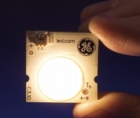Showing the way to effective lighting

The Lighting Design Awards have been a showcase of the best in lighting for 30 years — and this year is no exception.
While modern light sources and luminaires are capable of delivering lighting solutions that are both dramatic and energy efficient, it requires the skill and expertise of lighting designers to realise that potential. And Lee Prince, a partner with Light + Design Associates excels in the art and technology of lighting, winning for him in this year’s Lighting Design Awards the lighting designer of the year award, sponsored by DW Windsor.
The portfolio of projects of Light + Design Associates includes the Singapore Arts Centre, BT Tower and the Palace of Westminster. The practice has no particular house style, but tailors each of its designs to suit the location, ambience and architecture of the project.
The judges cited Lee Prince for his ‘tremendous versatility and skill’ in delivering such a diverse range of projects. They commented, ‘Whereas some lighting designers develop a style and bring a similar approach to their schemes, Lee produces highly varied but appropriate solutions according to the nature of the project. The design process and the need to engage the client and other construction professionals are also areas where Lee Prince displays exceptional ability and understanding.’
Two of his projects featured in this year’s awards. One was the winner of the leisure category, sponsored by Lutron Lighting Controls, Gymbox 3 in London’s Threadneedle Street. Other schemes in which Lee Prince was involved include Banana Republic on Regent Street in London, which was highly commended in the retail sector, and the European headquarters of Cisco Systems in Middlesex, which was commended in the special-projects section.
The scheme for Gymbox 3 exploits the space’s dependence on artificial light to create a hard-edged, contemporary answer to the conventionally bland gym.
The judges observed, ‘The rugged interior of the former bank vaults is directly complemented by the almost industrial feel of the lighting equipment. Colour was used dramatically to give excitement and theatre to the task of working out.’
Energy-efficient lighting does not have to be dull, as demonstrated by Strand residence in London, winner of the section for residential projects sponsored by Concord, and with lighting design by Firefly Lighting Design. Although luxurious, the project meets Part L.
The scheme demonstrates a close collaboration with the interior designer to provide a highly appropriate solution for an Art Deco-style penthouse. There is a high degree of customisation, and every detail has been carefully considered. — from low-voltage fittings which are turned up to full brightness for arrival in the lift lobby to LEDs concealed in niches, around the base of the bath and over the shower in the bathroom.
LED fittings in round feature ‘skylights’ were purposely positioned to create varying intensity, as an even glow would not have been in period.
Another fine example of the contribution that LEDs can make to reducing energy consumption was the winner of the low-carbon section, sponsored by Etap Lighting. That project was the British Airways lounges in T5 at Heathrow Airport, with lighting design by Pinniger & Partners.
The brief was to create a boutique hotel environment with as small a carbon footprint as possible (15 W/m2). There were three brands (Concorde, First and Club World) and six locations covering fine dining, bars, spas and lounges.

A key lighting technique was layering, using subtle light coves and backlit coloured panels of glass, and creating views and vistas through layers of translucent materials.
The main light sources are fluorescent and LEDs, with tungsten halogen used for accenting only where necessary. The judges commented, ‘The overall composition skilfully demonstrates how low-energy sources can be used successfully in luxury environments.’
Lighting that has, of necessity, to be functional and interesting rather than dramatic does not escape the attention of the judges of the Lighting Design Awards — with Terminal 5 at Heathrow Airport shortlisted in the category for public buildings .
This massive project encompasses the lighting for all external and internal public spaces that affect passengers. A key challenge was to keep a consistent quality of light over a vast site, which covered everything from the main building to the bus station and entry roads, especially as technology progressed over the 8-year span of the project. The final scheme was described by the judges as more than meeting the multiple and often conflicting objectives.
Another example of the constantly developing role of LEDs was the winner of the category for light sources and controls. GE Consumer & Industrial won this category, sponsored by Ex-Or, with its Vio high-power white LED.
Vio is a new technology platform that uses a chip emitting ultra-violet radiation at 405 nm with a patented multi-phosphor that is activated by this frequency to produce visible light. The principle is similar to that used for fluorescent lamps, although the phosphor blend is unique.
The Vio lamp is a full-spectrum light source with virtually no colour shift as the visible light is derived from a single phosphor. It can deliver consistent white light for up to 50 000 h.
Another LED lamp that was commended was Philips Lighting’s Affinium freezer module. Its benefits compared with conventional fluorescent lamps include consistent efficiency in cold temperatures, cooler running and longer life. Its optics also allow light to be directed to the front of the products displays, improving efficiency and enhancing brightness. Its performance is complemented by its life of seven to 15 years, compared with six to 12 months for fluorescent lamps.
While it may be tempting in this era of having to meet carbon footprints for buildings to focus on how much energy is used by lighting, there are plenty of examples in the Lighting Design Awards of how aesthetics and energy efficiency can be combined. Energy-efficient lighting does not have to be functional and unexciting.








